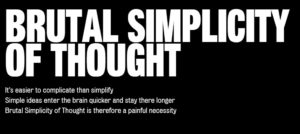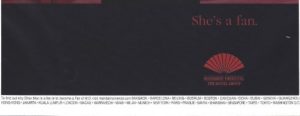Mandarin Oriental ad
It doesn’t say the right thing. It whispers them

This ad, and the long running campaign of which it is a part, is not great. It probably won’t win any awards, be granted a place in the advertising hall of fame or even get many likes and shares on social media. But it is pretty damn good. And that, in the midst of the rising tide of crap that now pollutes the media environment, is something to be thankful for. Evelyn Waugh and Raymond Chandler are not Tolstoy or Shakespeare – but they are way better than Danielle Steele and James Patterson. If you want to become more ad-literate there’s a lot you can learn from Mandarin Oriental.
On the downside
The ad uses the traditional standby of a celebrity endorsement – so it doesn’t push the boundaries in terms of creativity. Also, the line ‘She’s a fan’, is a pun. Puns are easy. I’m not a big fan of puns. You spot them and they’re hard to resist – low hanging fruit in the garden of wit.
Setting aside these two gripes the rest of the ad is a masterclass in the art of advertising and branding. The more closely you examine it, and others in the campaign, the more there is to admire.
The hallmark of M&C Saatchi
This ad and campaign is the work of M&C Saatchi (as opposed to Saatchi & Saatchi). Charles and Maurice founded Saatchi & Saatchi in 1970. The brothers were ousted in 1995 and promptly set up M&C Saatchi. Most of the senior executives, along with quite a few clients, soon joined them. The agency they all left remained Saatchi & Saatchi and is now part of Publicis.
I worked at the original agency in the 1980s, before the split. Back then the company strictly adhered to a few simple principles that were drummed into every member of the team. When I studied the Mandarin Oriental ads it came as no surprise to discover they were the work of M&C Saatchi – they epitomise those original principles that the agency still espouses.
Simplicity
This ad is beautifully simple. That’s because the agency’s mantra has always been “brutal simplicity of thought”. Here’s a screenshot from the Principles section of their current website.

That means advertising that is ruthlessly single-minded. Say one thing, and one thing only. Say it in the most remarkable way possible. And ruthlessly eliminate absolutely everything that is not utterly essential. “Less is more” is a mantra you used to hear repeatedly in ad agencies but Saatchis were more serious than most in applying it.
Simplicity is devilishly hard to achieve, certainly in advertising. Advertising and marketing is full of people with big egos. So they generally have something to say and want to put their mark on things. That makes it very hard to create single-minded ads and campaigns. It takes brutality to put people back in their box and achieve simplicity.
Don’t show off
If you want to get ahead in advertising and marketing you have to be a great self-promoter. This has always been the case but I think it has got worse in recent years, thanks partly to social media. People who build brands have realised that the same skills can be applied to themselves. Personal branding is an activity every ambitious individual has to assiduously practice – if you don’t, you’re obviously not with the programme, and a loser (so get a beard, for starters…).
What this means is that every ad you help create, every campaign you are associated with, is an opportunity to boost your own credentials. You have to get your name on it, put your mark on it, take ownership of it and turn it into some kind of personal asset. Creatives have always done this, putting together a portfolio (or “book”, as it was quaintly called in my pre-digital days). Nothing wrong with this, as I think one’s work is the best way to show your capabilities. And planners, executives, people on the client side now do the same, for the same reason.
The problem with this is that the ad or campaign becomes an opportunity to showcase one’s own personal brilliance – and the main purpose, to sell or promote the product/service/client, becomes secondary. This leads to ads that are self-consciously clever and attention seeking.
It’s not a new problem. The really smart people were well aware of the risk many years ago. Bill Bernbach, in the middle of the last century, wrote “Our job is to sell our clients’ merchandise … not ourselves. Our job is to kill the cleverness that makes us shine instead of the product. Our job is to simplify, to tear away the unrelated, to pluck out the weeds that are smothering the product message.”
When I worked at the original Saatchi & Saatchi I heard one of the Creative Directors, James Lowther (who moved with Maurice and Charles to M&C Saatchi) explain that “you don’t want the target audience to go ‘ooh, what a clever ad.’ You want them to go ‘ooh, what a clever product’”
I think the Mandarin Oriental ad and campaign is a perfect example of the agency people and the client people resisting the temptation to show off. Everything about it is self-effacing and brutally minimalist. The hero is the customer, the brand is discreetly in the background and the hand of the agency is nowhere to be seen.
Art direction
I’m a copywriter, not an art director. But a good copywriter, I believe, should be visually aware. I see so many copywriters write the words with no thought to how they’ll work on the layout…don’t get me started.
So, here’s an observation on one aspect of the art direction. Most brands have a particular colour palette, and the logo generally appears in the same colour; Pepsi is red, white and blue, Starbucks is green, Amazon is black and yellow. This is sacrosanct, enshrined in a brand bible – under no circumstances must these ever colours change or vary.
But look at these four different Mandarin Oriental ads.




The colour of the bottom panel, and the logo, changes every time to match the colour of the guests’ clothes. This does two things. It creates a beautifully harmonious, calming and pleasing look. It also says “We put clients first – even to the extent of changing our brand identity to suit them”. It suggests, without doing anything so clumsy, clichéd or crass as to put this thought into words, that the company totally personalises the service to the guest’s individual tastes and sense of style. One of the testimonials on their website underlines this: “If I wake up in a Mandarin Oriental Hotel then I probably feel like I am at home”. The advertising consciously, and subtly, promotes this feeling by making the featured celebrity look at home in the ad. It’s also flattering, but without being obsequious.
Creating curiosity
There is almost no text. And many of the celebrities (setting aside those ads that feature the likes of Morgan Freeman and Helen Mirren) are not instantly recognisable. They kind of look familiar, but I think most people would struggle to put a name to the face.
This makes you search the ad for clues. On each one there’s a line at the bottom, in type so small it’s almost invisible, that reads “To find out why Chen Man is a fan or to become a fan of M.O. visit mandarinoriental.com”. Chen Man, should I know her? Better check it out.

The ad works well as click bait, leading you to a page with text and videos which introducing Chen Man, her art/photography and the reasons she chooses to stay at Mandarin Oriental. If the campaign only featured the likes of Angelina Jolie or George Clooney I probably wouldn’t bother to click through. As it is I visit the website and discover something I feel I should have known already….if I moved in the right circles! There’s a subtle inference of exclusivity, of a club to which you don’t belong…yet. It’s aspirational, playing on our FOMO (Fear Of Missing Out).
It the ad had Chen Man’s name more prominently, with “Chen Man is a fan” as the headline, or her name bigger at the bottom, this would have backfired. It would have undermined her by suggesting that she’s not sufficiently well known. By doing the opposite it increases her mystique and cachet whilst piquing our curiosity and making us feel like an outsider. By saying less the ad achieves more.
Smart strategy
Celebrity endorsements (when done well) achieve a number of things. They instantly make the brand aspirational. Who wouldn’t want to stay in the same hotels as Morgan Freeman, Darcey Bussell, Helen Mirren and even the slightly less well known Chen Man, Sophie Marceau and Rami Malek?
The fact it’s the choice of celebrities says more about the brand than it could ever say about itself. Each of these celebrities brings with them their own story. Mandarin Oriental doesn’t have to add anything more. The people they have chosen to feature are stylish, cultured, sophisticated, talented and their values become the brand’s own. It enables M.O. to create ads that are stylishly, tastefully, comfortably discreet, understated and minimalist. Ads that promise impeccable service, superb attention to detail and aesthetic delight. Without saying it explicitly.
Unlike many other luxury brands it doesn’t strut, brag or flaunt. There is no hint of bling. It is surprisingly modest and exudes good taste. They’ve achieved something very difficult whilst making it look easy – managed to convey all the right things, things their target audience wants to hear, without appearing to try.

 GOOD AD, BAD AD, UGLY AD is written by saddle sore copywriter
GOOD AD, BAD AD, UGLY AD is written by saddle sore copywriter
Recent Comments